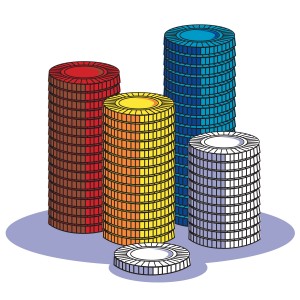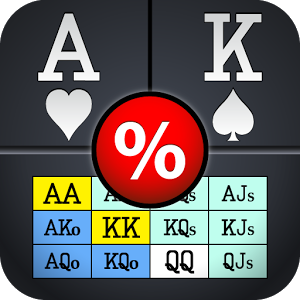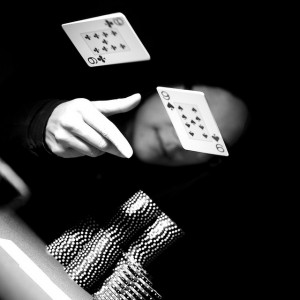After listening to Ed Miller speak at last year’s ITH convention, I made up my mind that I wanted to learn how to play no-limit cash games. Given their popularity at the moment it seemed silly not to have this game in my arsenal. Six months later I am now reasonably confident playing the game and have some nice positive numbers over a decent-sized sample. I still consider myself a relative newbie at the game. Don’t worry, I’m certainly not going to sit here and try to tell no-limit players how to improve their game. However, what I would like to do is provide some tips for limit players who are thinking about learning no-limit cash games.
Limit and no-limit hold’em are theoretically quite similar. The only significant difference is the amount you are allowed to bet at a time. Naturally this means that if you are an accomplished limit player, you should have at least a reasonable idea how to play no-limit hold’em. In fact, if you have a strong theoretical grasp of poker, you may even find you can win right away, at least at the lower limits. Nevertheless, the games are different enough that no-limit hold’em provides many trappings for the limit player. In fact, the apparent similarity of the games can ambush them, as they carry habits over from their limit game that can be disastrous in the big-bet version of the game.
In this article, I will identify ten things that a limit player will have to adapt to when playing no-limit holdem. They are the ten things that I found most fundamental when trying to master no-limit cash games coming from a limit background. Hopefully identifying them here may help other limit players looking to make the transition.
1. Big decisions
No-limit is about forcing your opponent to make a decision for all of his chips. Actually I wholeheartedly disagree with that cliché but, for a limit player, having to choose whether or not to push your entire stack into the middle is indeed one of the most obvious differences from what you will be used to at limit tables. Limit hold’em is generally about making a series of decisions each hand, each of which gaining or losing you small fractions of a big bet in expectation. No-limit hold’em is more about making long strings of mundane, even obvious decisions, followed by one big decision that will win or lose you a buy-in either directly or indirectly.
It is important to identify these decisions and make the best EV decision when you encounter them. When I first started playing no-limit, I found that I would be too cautious in these situations, folding more often than I should to all-in bets and not going all-in enough myself with either a made hand, a draw, or a bluff. Also I would try to avoid these big decisions by intentionally keeping the pot small, when my hand warranted playing a big pot. It was almost certainly a natural aversion to something with which I was unfamiliar. Making decisions for your entire stack is an important part of no-limit hold’em that you have to confront sooner or later. By observing your opponents carefully and calculating your equity against their likely range, you will put yourself in a position to make these big decisions highly profitable rather than costly.
2. Planning
In no-limit holdem it is vital that you plan your hand. Whenever you play a pot you have a think about not just the street you are currently on, but also future streets as well. This is somewhat important in limit hold’em too, but in no-limit your actions on one street can have huge knock-on effects on other streets. You need to identify and manage the entire hand, knowing where each bet, raise, check and call is going to take you. You especially need to know if you intend to commit your entire stack and if so how and when do you intend to do it.
For example, betting the flop will cause the pot to become much larger if your opponent calls. This might commit you to the pot on a later street if your opponent plays back at you. However, if you check behind instead then you will have to know what you will do if your opponent bets the turn. As you checked the flop it could easily be a bluff, but if you call then are you willing to call again on the river? Of course, the answers to these questions will depend on a number of factors, but the important thing is that you at least address them. Playing one street at a time is inadvisable in limit hold’em, but really doesn’t cut it in no-limit.
3. Value betting
Value betting is extremely important in limit holdem. In fact, it is where we derive most of our profit. In no-limit hold’em, value betting is also important, but it must be wielded with more care. ‘I’ll bet because I think I’m ahead’ is not a good line of thinking in no-limit hold’em. Because the bets involved will be much larger in proportion to the pot, it is important to be concerned not so much with having the best hand, but having the best hand when called. If you value bet too liberally you will find yourself winning the small pots and losing the big ones. You will also find yourself in some tough spots when your opponent raises over the top of you.
4. Top pair
I remember reading a quote once that said top pair was a great hand to win money with in limit hold’em and a great hand to lose money with in no-limit hold’em. Now I play both games a lot, I appreciate the truth in this statement. Top pair, even with top kicker, in no-limit hold’em is a dangerous hand. It is right on the cusp of what players are prepared to call large bets with, so the unfortunate reality is that you will tend to get action mostly from hands that beat you, while hands you beat will fold. Sometimes you will be forced to commit your stack with top pair, but it will always be an anxious moment when you do.
In no-limit hold’em you often need to play top pair cautiously. It is usually a bad idea to pay a pot-sized bet on the flop, turn and river with just top pair. You often need to exercise pot control (see below) in order to get to showdown cheaper if you and your opponent both have large stacks. You often end up kicking yourself if you get all-in with 100 big blinds or more with only top pair against most opponents.
5. Changing hand values
The danger of top pair is reflected in the hands that you should choose to play in no-limit hold’em. Hands that rarely make anything better than top pair, such as AJ, AT and KQo and even more so hands that make weak top pair such as QJo and KT are not nearly as valuable as they are in limit. AK and QQ are similar in value in limit, but worlds apart in no-limit. Meanwhile hands that are good at cracking top pair, such as small pairs (that make sets) and suited connecters (that make straights and flushes) increase in value. A hand being suited matters far more in no-limit hold’em than it does in limit, because it dramatically increases its big hand potential. If you are a limit player learning no-limit hold’em, you need to get back to basics and read up on what constitutes a good starting hand in the big bet variety of the game and in what positions to play them.
6. Pot control
This is the concept that was probably most alien to me as a limit player. Sure, there are times you want to keep the pot small in limit hold’em, but it is usually a secondary concern to maximising your expectation through value betting. In no limit holdem, there are situations where you want to play a small pot and situations where you want to play a big pot. Identifying the difference between the two is a key skill that you will need to master. Whether you want to play a large or a small pot will depend on a number of factors including the strength of your hand, the type of opponent you are up against, your likelihood of improving and your position. Generally speaking you want to play a big pot if you want to get all-in, either on the strength of your hand now or if you hit your draw. You want to play a small pot if you want to go to showdown, but don’t want to commit a large number of chips to do so.
Remember, in no-limit holdem, the bigger the pot is, the bigger the bets will be on subsequent streets. If you go around raising top and middle pair haphazardly on the flop, you will often find yourself facing big bets that you don’t want to call, but you feel your hand is too good to fold. You may need to check behind with seemingly good hands or check/call rather than bet and risk getting raised. At the same time with your big hands and big draws you will often want to raise to allow yourself to get all-in on subsequent streets if you desire. This all goes back to the planning mentioned earlier.
7. Stack size
Stack size is rarely relevant in limit hold’em. It is only important if one of your opponents has a stack so small they are liable to get all in at some point in the hand. In no-limit hold’em it is always possible that somebody will get all-in at some point in the hand and you have to plan for that eventuality. This means always being aware of the stack sizes of both you and your opponents because it could (and should) have a big impact on your decisions.
For example, let’s say you have AJs in the small blind. An aggressive and somewhat loose player raises to four times the big blind from middle position and it is folded to you, what do you do? This is a question that it is impossible to answer without knowledge of stack sizes. If they have a very small stack you might consider going all-in figuring you are a favourite against their range. If they have a medium stack you might fold, not wanting to play a pot out of position against a hand that may well dominate you. If both your and your opponent’s stack are very large, you might cold-call hoping to flop a big draw or 2-pair or better and win a very big pot. Three stack sizes, three completely different plays. Playing according to stack size is something a limit player will not be used to and an extremely important skill to master.
8. Implied odds
Implied odds are something that you pay lip service to in limit hold’em, but they are rarely an overriding factor. In this day and age you can’t rely on getting callers on the expensive streets and if you do it often doesn’t add up to much. In no-limit on the other hand, implied odds are hugely significant. If you bet between half the pot and the whole pot on each street, then the size of the bets snowball and those on later streets can become very large compared to the pre-flop and flop bets. As a result it can be very profitable to pay a small bet (such as a pre-flop call) if there is a chance you might snare much larger bets with a winning hand later on, even if that chance is fairly small. This isn’t really the case in limit hold’em, because even the big pots aren’t really big enough except in loose games. The flip side of the coin is that you need to be wary with hands that tend to make good-but-not-great hands (such as top pair) that are liable to lose those big pots. Reverse implied odds are your enemy.
9. Bluffing
Bluffing in no-limit hold’em is the same in principle as it is in limit hold’em. You are making a bet in the hope of folding a better hand. However, in practice they actually work very differently. In limit hold’em bluffing is a low-risk move (even a bluff raise only costs two bets) but with a relatively small chance of working, because your opponent only has to pay a fraction of the pot to call. In no-limit hold’em bluffing is much higher risk because you have to bet a fair proportion of the pot to make your bluff convincing and to prompt your opponent to consider folding. As a result you should only bluff in no-limit if you are fairly confident your opponent will fold.
Secondly you should consider bluffing with different hands. In limit hold’em you are betting in the hope that your opponent doesn’t have anything (but still more than you). You don’t want to bluff with marginal hands that have showdown value because you will tend to prompt better hands to call and worse ones to fold. In no-limit on the other hand, the hand you are bluffing with does not need to be so precise. If you make a large bet at the right time, your opponent could be willing to fold hands as good as two pair or even better on a scary board, especially if they face the prospect of a further large bet on subsequent streets, so you can bluff effectively with much better hands, even ones that may be good enough to value bet in different circumstances.
10. Different styles
In limit hold’em it is difficult to be successful outside of the tried and tested tight-aggressive framework. Sure, in a 6-max game you might be successful with Poker Tracker stats as nitty as 17/10 or as LAGgy as 35/25, but these extremes still represent a fairly narrow range of styles. In no-limit your pre-flop stats don’t matter so much as more styles become viable depending on the texture of the game and your post-flop skills. A loose/aggressive style can be profitable if you are a skilled post-flop player, due to the bigger implied odds. Meanwhile very tight and passive styles can work in loose games where you can expect to win big pots when you hit.
This is good news for players who want to play with a bit more creativity, but bad news when it comes to quickly determining the skill of your opponents or how good the table is. Looking at the table’s or a particular player’s basic PT stats can be very misleading. A 50/30 player could be a complete fish or a very good tricky opponent. You will have to rely far more on observations of how they play individual hands than the raw numbers.
The first step for a limit player looking to add no-limit to their arsenal is to recognise the ways in which the games are different. Of course, becoming an ‘expert’ no-limit player will require a lot of experience and a sound understanding of the game.
Maybe one day we will both get there.
Submit your review | |










